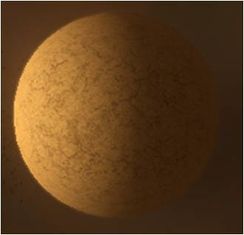Planet Waterford
| Planet Waterford | |
| Location | 3E, Leeds |
| Technical information | |
| Docking | No |
| Terrain | Ice |
| Diameter | 11,679 km |
| Mass | 5.32 x 10e24 kg |
| Temperature | -74°C to -58°C |
| Escape velocity | 11.03 km/sec |
A beautiful but barren world of magnificent ice formations. Glasgow Outpost orbits the planet, headquarters for Bowex. While Bowex often collects natural ice sculptures from the surface for use as place settings for official banquets, Waterford otherwise lacks any useful resources.
Research Done By the Cambridge Stellar Research Division
'This part is not Canon, it is purely based on In-Game and Forum Roleplay, by the Cambridge Stellar Research'
The ice of Planet Waterford contained sulphur what explained the yellowish tone. But the most interesting fact was,
that there were two kinds of water to be found. The charge of the two elements was just slightly different. The whole surface of the planet seemed to have melted about a millenium ago and the element found within the sculptures were not to be found before that point. It seemed that another stellar body, a large asteroid made of sulphur and water entered the atmosphere of planet Waterford and entered an orbit, slowly closing in on the planet. The asteroid started melting in the atmosphere and due to it's size
and the long time it stayed in the orbit before it hit the surface it heated up the planet so the upper layers of ice melted.
After some time the asteroid hit the ground and because of the high temperature it gained it melted the ice around it, sinking into the depths of the planet. The underground lake the scientists found is the location where it melted completely. This also explains the extreme concentration of sulphur within the liquid body of water. For the origin of the ice sculptures it seems that the ice from the asteroid seems to be harder as the molecules stay tighter due to their slightly higher electrical charge. The ice that originally existed on planet Waterford is less stable and is slowly being eroded by the wind. What stays are the amazing ice sculptures, almost entirely made of the remains of the asteroid.
- Detailed Info on - CSR surveillance mission #2
